Story Arcs in Script Analysis: Mastering the Backbone of Storytelling
Posted: April 24, 2023 | Updated: April 24, 2023
Posted In: Articles
We all know the story of Cinderella. A hardworking, beautiful woman is mistreated by her stepmother and stepsisters. Given a stroke of luck and magic when she is greeted by a fairy godmother, she attends a glamorous ball where she meets the man of her dreams. While she has to hurry back home, she leaves behind a glass slipper, the clue for which the prince uses to track her down and confess his love.
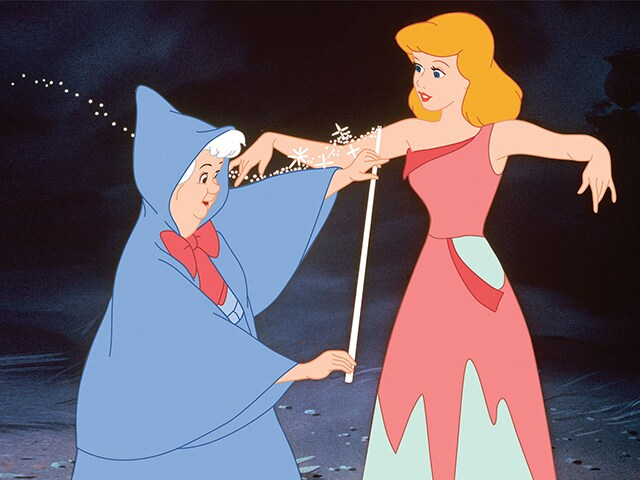
This tale may be a familiar one, but what you might not recognize is that it reflects one of the 6 popular archetypes for story narratives across various mediums.
These story archetypes or “story arcs” mark the rises and falls in a narrative (plot changes) that resemble specific patterns.
Story arcs work to apply data to establish the cause-and-effect relationship between what would seemingly appear as random events within a story. We can understand these patterns of events, or story markers to help us better understand a writer’s overall message or goal with his/her script.
Read more about story arcs, emotional trajectories, and their relationship to A.I. here.
Components of a Story Arc
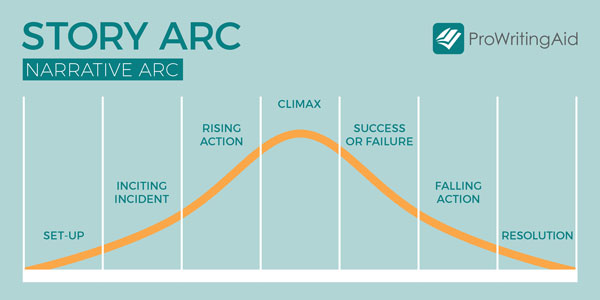
Now that you know what a story arc is, let’s discuss what it’s composed of.
Our AI script analysis process identifies story arcs by breaking down the sequence of events that build to a climax and collapse into a plateau. These include:
The Set-up – This is where any background information that leads to the event or change, providing the viewer with an essential understanding of what is causing the eventual rise in the narrative.
Inciting Incident – The initial or primary cause of the forthcoming rise.
Rising Action – Building off of the initial or primary event to create a heightened level of awareness for the viewer.
Climax – The peak in the narrative arc (when the conflict is brought to a head).
Success or Failure – Deciding repercussions of the action (subsequent resolution).
Falling Action – The narrative moves toward conclusion (ex: in a hero’s journey tale, this would be when the hero embarks on the journey home).
Resolution – The conflict has been solved, the story is resolved (either positively or negatively for the protagonist) and the intended meaning of the story is clear.
Types of Story Arcs
Although the world-famous writer and humorist Kurt Vonnegut’s masters thesis on “The Shapes of Stories” was initially rejected based on its simplicity, the world now recognizes his findings as the foundational structure for storytelling and script analysis.
Through his examination, Vonnegut outlined a basic graph for which any kind of story can be plotted. The vertical axis displays the level of fortune (good to bad) for which the character experiences and the horizontal axis represents the time (beginning to end) of a story.
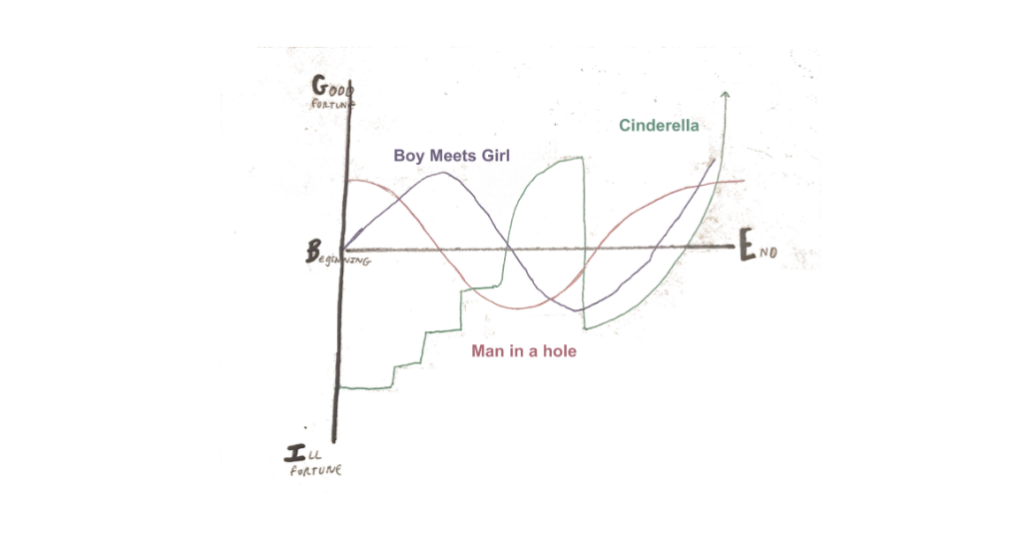
Using an initial study of over “thousands works of fiction,” Vonnegut found that there are 6 main shapes of stories. One of the most groundbreaking findings was the result that this rang true regardless of the number of variables in question.
In other words, even when conducting a script analysis of tens of thousands, even hundreds of thousands of scripts, the same 6 patterns would hold true.
What are these arcs?
Here are the 6 main story archetypes that Vonnegut identified and our script analysis is able to analyze:
- Rags to Riches (Rise)
- Riches to Rags (Fall)
- Man in a Hole (Fall-Rise)
- Icarus (Rise-Fall)
- Cinderella (Rise-Fall-Rise)
- Oedipus (Fall-Rise-Fall)
StoryFit’s unique script intelligence allows for an in-depth analysis of these archetypes. Using our script mapping tool, any writer or creator can examine their stories on another level.
Utilizing the dialogue and description in the subtext, StoryFit’s data displays scene by scene rises and falls within the narrative, to give you a better understanding of what your story looks like from a broader scale and an up-close lens.
Let’s look at the 6 archetypes more in-depth, and see how StoryFit’s sentiment plotting can measure these data trends to generate a visually clearer understanding of story arcs.
Rags to Riches (Rise)
A steady incline in “emotional valence,” this is seen in several classic narratives. While all stories have movement or change to propel the plot and enable their characters to act, this story arc is defined by a singular upward rise, likely leading to the famous “happily ever after” conclusion we often see in princess movies.
Popular Titles With This Archetype: My Fair Lady (1964), Pride and Prejudice (2005), A Winter’s Tale (2014), The BFG (2016)
StoryFit’s graph depicts The BFG’s Rags to Riches sentiment arc over the course of 96 scenes. Fans of the classic Roald Dahl tale will recognize the climax of the story around scene 69, where the BFG risks his life inside the cave to protect Sophie from endangerment.
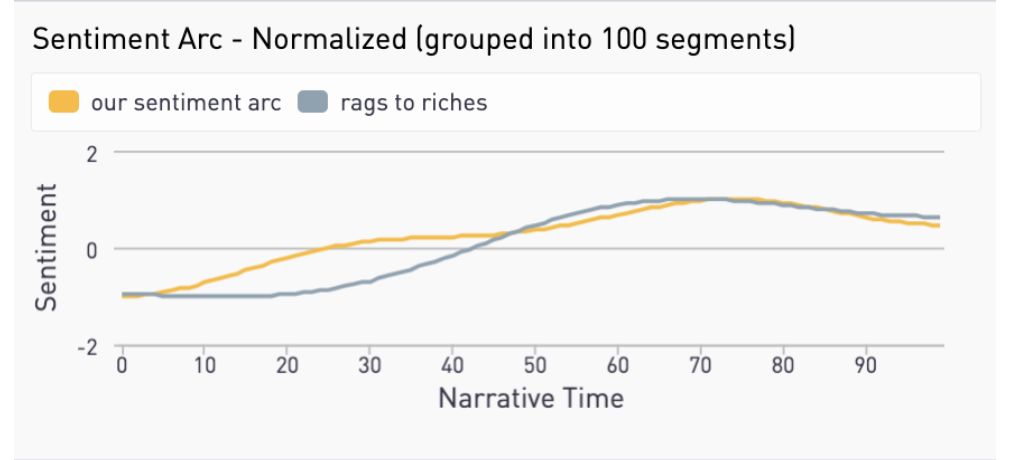
Riches to Rags (Fall)
Contrary to the Rags to Riches story arc, Riches to Rags depicts the opposite. In this narrative, the slope of the arc goes on a continuously downward spiral rather than a rise.
This plot line often depicts a protagonist beginning with a symbol of high status (lots of wealth, great job, perfect family) and showcases the steep deterioration of their lives by the end of the story. Oftentimes these stories center around a singular lead, who’s bad habits or ill intent eventually catches up with them. Stories about mental health and addiction fit into this story archetype.
Popular Titles With This Archetype: The Great Gatsby (2013), House of Gucci (2021), Tár (2022)
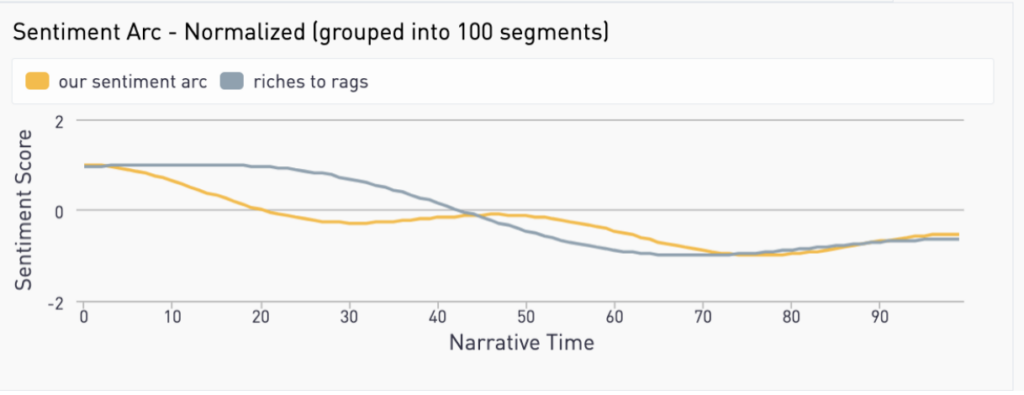
The story arc above depicts the journey of Lydia Tár, the award-winning composer whose life seemingly crumbles when she is accused of sexual misconduct in the film, Tár.
Audiences are drawn to stories like these because they utilize the intricacies of character perspective and relatability to showcase human flaws in character development.
StoryFit data helps to reveal how a tight control of perspective, a focus on social issues such as sexual abuse and identity politics, and highbrow tones all work together to construct a riveting psychodrama about a character’s objective audiences are engrossed by.
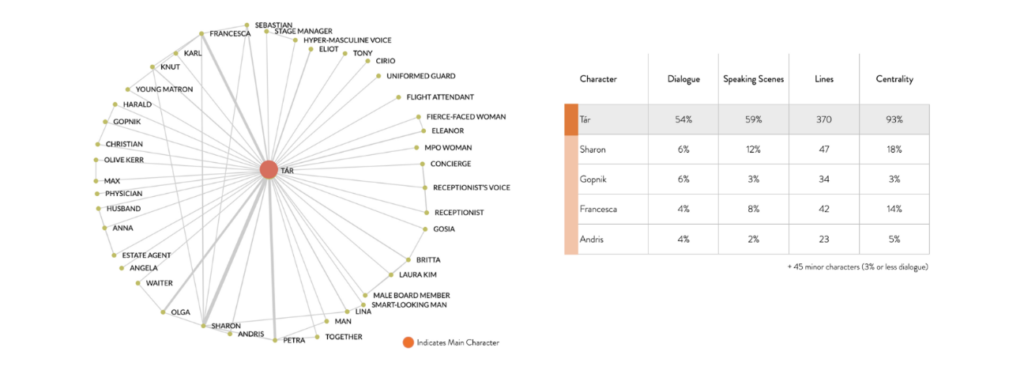
Tár’s character network, which is shaped like a near-perfect wagon wheel revolving around Lydia Tár, illustrates the film’s tight focus on Tár’s perspective, rather than other characters. This shape is especially striking when compared to other character arcs that depict multiple perspectives and character journeys.
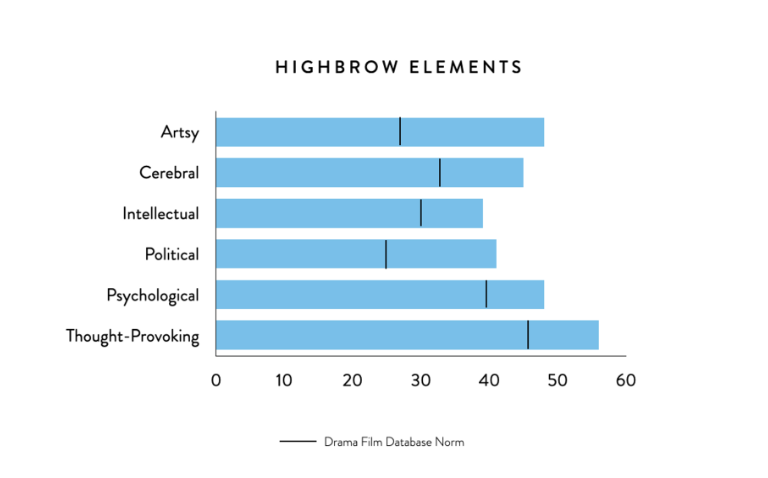
Tár indexes as much more Artsy, Cerebral, and Intellectual than the drama film norm, as befits a film about the intensely artsy and intellectual classical music space. The film’s interest in social issues (sexual abuse, identity politics, and power) drives a high score in Political. Tár creates a Psychological atmosphere by honing in on Lydia Tár’s fractured mental condition. The film’s exploration of an often unsympathetic and abusive protagonist makes for a Thought Provoking viewing experience.
Man in a Hole (Fall-Rise)
Perhaps the most common story arc of all 6, Man in a Hole occurs when a narrative falls and then rises to a similar or even higher status, depicting a large dip that justifies the name.
Sometimes there is only one drop-rise in a story (perhaps occurring in a particular scene) and other times there are two sequential drops. This would be labeled as a “double” Man in a Hole (as seen in classics like Harry Potter and The Prisoner of Azkaban, and The Lion King).
Popular Titles With This Archetype: The Hobbit (2012), Finding Nemo (2003), Alice in Wonderland (2010), Tangled (2010)
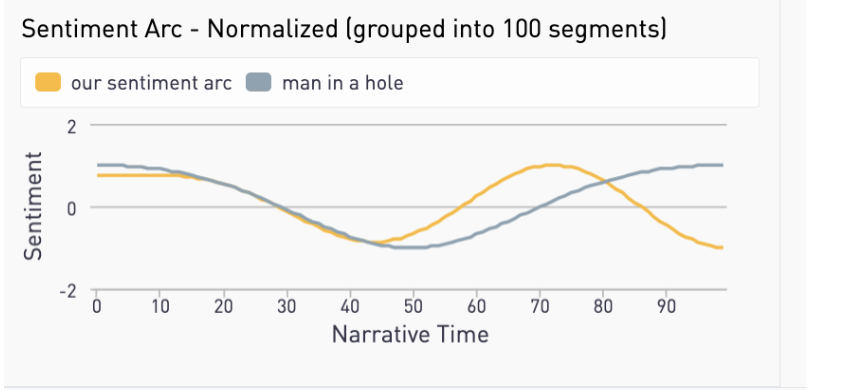
The graph above depicts the narrative of Tangled, a 2010 Disney animated feature about Rapunzel’s journey to escape from her tower and discover her true family.
Icarus (Rise-Fall)
Frequently known as, “Freytag’s Pyramid,” this archetype describes not an overall structure, but a single arc. Icarus is named after the Greek mythology story about a boy who is stranded and imprisoned on an island and makes wings out of wax to escape. As he escapes, his wax wings come too close to the sun and they melt, prompting him to fall into the sea.
Popular Titles With This Archetype: The Hunger Games (2012), Jurassic Park (1993), Great Expectations (2012), 10 Things I Hate About You (1999).
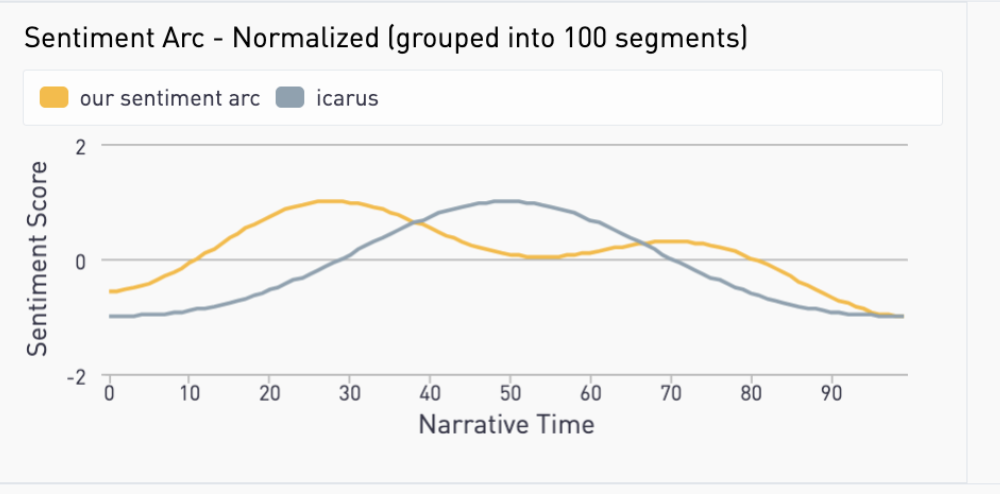
10 Things I Hate About You is a well-known Romantic Comedy from the late 90s that follows this story format.
Cinderella (Rise-Fall-Rise)
A love-story as old as time, this princess tale is distinguished enough to garner its own character arc.
The rise-fall-rise structure is frequently used among love stories and coming-of-age films, but did you also know it’s a popular framework for Academy Award-nominated films as well?
Our script analysis software showed that Vice, a 2018 Oscar nominee about Dick Cheney’s life and impact on the Bush Administration, follows the format of the classic fairy tale. You can read more about it here.
Popular Titles With This Archetype: Jane Eyre (2011), Vice (2018), Aladdin (1992).
One of 2022’s Oscar nominees, Triangle of Sadness, was written similarly.
Swedish director, Ruben Östlund makes his English-language film debut in this satirical comedy about a highfalutin couple invited to join a luxury cruise for the wealthy.
Things quickly go from bad to worse as the characters are left to helplessly fend for themselves while being stuck with one another.
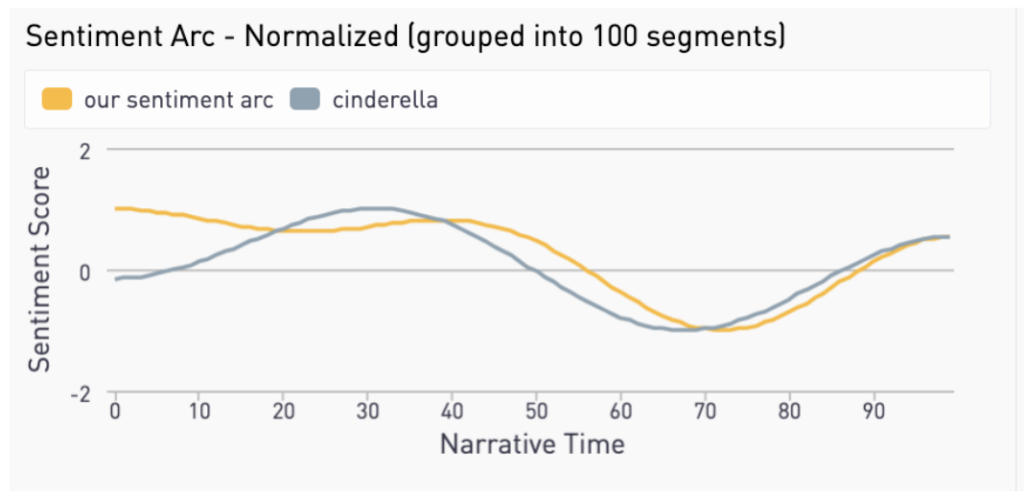
Additionally, StoryFit analyzed this Oscar-nominated film to get a better understanding of the comedic and narrative themes at play.
In other words, how ridiculous can a cinderella script be while simultaneously getting viewers to keep watching?
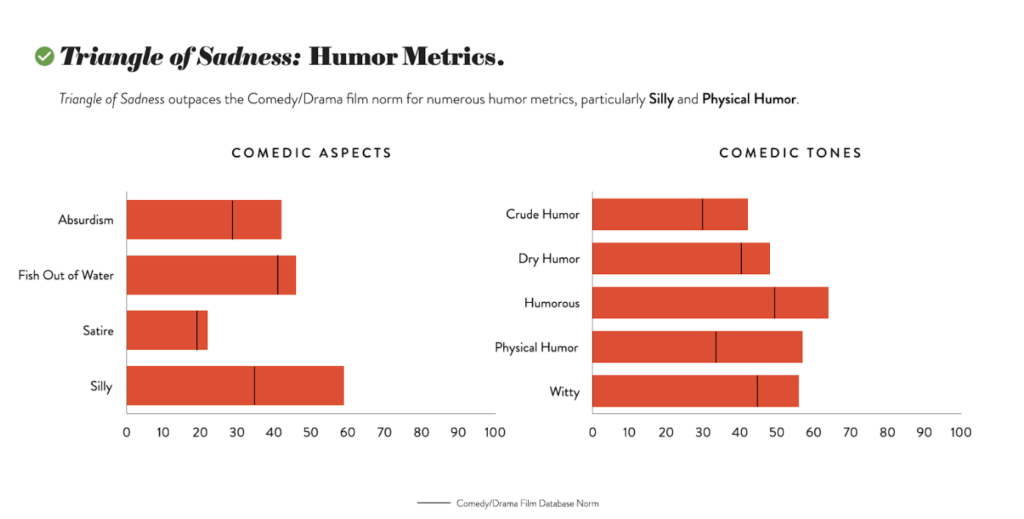
Compared against our database of Comedy/Drama films, Triangle of Sadness successfully outpaces the norm in several comedic aspects, most notably Silly and Absurdism.
We can also see that the film presents several types of humor as a way to poke fun at the rich, using Physical Humor to degrade its characters (we think you know the scene we’re talking about).
Oedipus (Fall-Rise-Fall)
Lastly, but certainly not least, Oedipus story archetype is perhaps the hardest story structure to apply, and used most commonly in famous works of literature.
Francis Ford Coppola, the director of the infamous Godfather Trilogy, is known for his strategic storytelling and artistic style. He applies the Oedipus arc to the 1972 Crime-Drama classic.
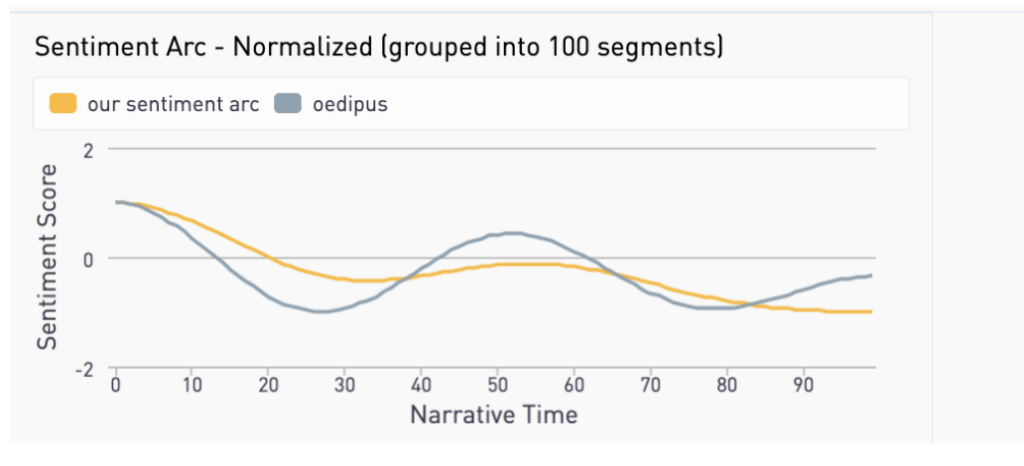
Popular Titles With This Archetype: Gone with the Wind (1939), The Sun Also Rises (1957), Gone Girl (2014), The Godfather (1972)
Mastering one of the six story archetypes is the best way to build a great story and create tension for your audiences. Seemingly simple, these structures are complex when done effectively and serve as the backbone for compelling storytelling.
Want to build out your story structure or analyze a script in more detail ?
StoryFit can help!
